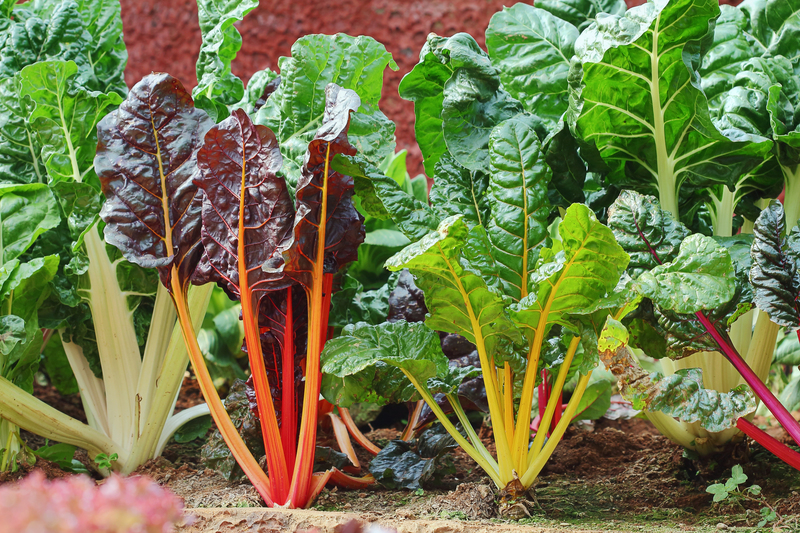Sky-High Gardening: The Vertical Approach
Posted on 25/08/2025

Sky-High Gardening: The Vertical Approach
In today's urbanized world, living spaces are shrinking, but our passion for greenery thrives. Sky-high gardening, also known as vertical gardening or vertical horticulture, is transforming the way we cultivate plants in limited spaces. Whether you're locked in a cozy apartment or seeking to maximize your backyard, going vertical opens a universe of creative possibilities. In this comprehensive guide, we'll delve into the principles, benefits, and practical aspects of vertical gardening.
What Is Vertical Gardening?
Vertical gardening refers to the practice of growing plants upward--on walls, trellises, fences, or freestanding structures--rather than spreading them horizontally over the ground. This method allows you to make the most of unused vertical surfaces, turning dull walls and fences into lush, living tapestries. Sky-high gardening is perfect for urban residences, small patios, schools, and even office buildings looking for a green touch.
Popular Forms of Sky-High Gardening
- Green Walls (Living Walls): Entire walls covered with vegetation, often with built-in irrigation systems.
- Vertical Planters: Hanging pots, stacked containers, or pocket systems affixed to walls or fences.
- Trellises & Arbors: Traditional structures supporting climbing plants like vines, roses, or cucumbers.
- Pallet Gardens: Upcycled wooden pallets filled with soil and plants.
- Freestanding Towers: Column-shaped planters or structures that can be moved and rearranged.
Why Choose the Vertical Approach in Gardening?
Sky-high gardening isn't just a trend; it's a solution-driven design philosophy. Here's why so many gardeners--newbies and experts alike--are scaling up.
Key Benefits of Vertical Gardening
- Maximizes Limited Space: Ideal for urban dwellers who have balconies or small courtyards. Vertical gardens unlock space that would otherwise remain bare or underutilized.
- Enhances Aesthetics: Living walls are visually spectacular, creating vibrant focal points indoors or out.
- Improves Air Quality: Plants are natural air purifiers. A vertical setup introduces more greenery, resulting in cleaner, oxygen-rich air.
- Reduces Urban Heat: Vertical gardens help insulate buildings, lower the urban heat island effect, and reduce energy use.
- Boosts Privacy & Soundproofing: Lush walls can act as natural barriers, muffling noise and blocking unwanted views.
- Supports Biodiversity: Attracts birds, bees, and beneficial insects--crucial for healthy ecosystems.
- Grows More Food: You can cultivate herbs, veggies, and even fruits vertically, increasing your output in limited areas.
Getting Started with Sky-High Gardening
Starting your own vertical garden is easier than you think. The secret lies in creative planning and choosing the right combination of plants and materials. Here's a step-by-step approach.
1. Assess Your Space
Identify walls, fences, railings, or sunny nooks that could support vertical growing. Measure dimensions, note the amount of daily sunlight, and check the sturdiness of your support structure.
2. Choose the Right Vertical System
- Freestanding vs. Wall-Mounted: Decide if you want a system attached to a wall, fence, or independent structure.
- DIY vs. Pre-Fabricated Kits: Many vertical garden systems can be purchased or created from upcycled materials like pallets or shoe organizers.
- Mobility: Will your garden stay put, or do you need something portable?
3. Select Suitable Plants
Not all plants are well-suited to vertical growing. Here are some excellent choices:
- Trailing and Climbing Varieties: Ivy, peas, beans, clematis, and morning glory.
- Compact Edibles: Strawberries, lettuce, spinach, kale, and most herbs.
- Ornamentals: Ferns, succulents, air plants (Tillandsia), and pothos.
- Flowering Beauties: Petunias, nasturtiums, and pansy varieties thrive in vertical planters.
Design Tips for a Sky-High Garden
The art of sky-high gardening goes beyond functionality--it's also about creating a visually stunning environment. Follow these tips for an unforgettable living wall:
- Mix Textures & Colors: Create contrast by pairing bold foliage (like succulents) with delicate ferns and flowers.
- Tiered Planting: Place sun-loving plants at the top, shade-lovers below. This mimics a natural light gradient.
- Integrated Irrigation: A drip or soaker hose system ensures consistent watering for all levels.
- Artistic Patterns: Arrange plants in geometric designs or waves for a dramatic look.
- Personal Touches: Add decorative items like sculptures, LED lights, or small garden signs.
Clever DIY Vertical Garden Ideas
- Repurposed Shoe Organizers: Fill each pocket with potting soil and herbs for a kitchen wall garden.
- Pallet Gardens: Mount a wooden pallet vertically, fill slats with soil, and insert plants.
- Gutter Gardens: Attach horizontal gutter pipes to a fence; perfect for strawberries, lettuce, or flowers.
- Plastic Bottle Planters: Upcycle plastic bottles as hanging planters for small leafy greens.
The Best Plants for Vertical Gardening
The success of your vertical garden largely depends on plant selection. Focus on species that either climb, cascade, or remain compact. Here's a helpful breakdown:
Edible Plants for Vertical Growing
- Herbs: Basil, mint, chives, oregano, thyme, and parsley flourish in vertical systems.
- Leafy Greens: Lettuce, Swiss chard, kale, arugula, and spinach grow fast and don't need deep roots.
- Vegetables: Cherry tomatoes, snap peas, cucumbers, and bush beans are top choices.
- Strawberries: These fruiting perennials thrive in containers and wall pockets.
Ornamental Varieties
- Creeping Jenny and Ivy add trailing beauty and coverage.
- Pothos, spider plants, and philodendron provide lush, low-maintenance greenery indoors.
- Succulents like sedum and echeveria create geometric, drought-tolerant displays.
- Flowering plants--including impatiens, fuchsia, lobelia, and begonias--add vibrant color to living walls.
Building & Maintaining a Vertical Garden
Essentials for Successful Construction
- Light: Understand the orientation of your wall (north, south, east, or west) to match plants with their ideal sunlight requirements.
- Weight Support: Ensure that your chosen wall or frame can handle the weight of moist soil, plants, and water.
- Soil: Use high-quality, lightweight potting mix to facilitate drainage and aeration.
- Watering System: Drip irrigation or a capillary mat ensures water is distributed evenly to all vertical levels.
- Drainage: Proper drainage is critical to prevent root rot and mold. Incorporate trays or drainage spouts at the bottom.
Ongoing Care for Your Vertical Garden
- Regular Watering: Monitor moisture levels, especially in hot weather. Automated timers help maintain consistency.
- Fertilizing: Use slow-release or liquid fertilizers every few weeks to keep plants healthy and lush.
- Pruning & Deadheading: Trim back fast growers and remove spent flowers to encourage vigorous growth.
- Pest Control: Check for insects or fungal issues that thrive in humid microclimates.
Vertical Gardening in Urban Environments
Urban rooftops and city balconies are perfect candidates for sky-high gardening. Vertical plantings not only brighten concrete jungles but also foster a connection to nature. In dense cities, living walls have a transformative effect, lowering stress and even filtering traffic noise.
Case Study: Urban Green Walls
In cities from Singapore to New York, majestic green walls on buildings have become urban landmarks. These living installations make use of hydroponics, lightweight soil mixes, and custom irrigation to sustain vast tapestries of plant life dozens of feet above ground. The Changi Airport's "Green Jewel" is a world-famous example, showcasing a spectacular vertical rainforest.
Common Challenges & Solutions
- Water Management: The top rows can dry out faster than the bottom. Use absorbent mediums or stagger watering zones for balance.
- Structural Integrity: Double-check anchors and wall fixings, especially in exterior or wind-prone locations.
- Pests & Diseases: Increase air circulation and choose pest-resistant varieties when possible; regular inspections help catch issues early.
- Plant Selection: Match plant needs meticulously to the microclimate of your space: shade-tolerant for indoor walls, drought-resistant for sunny exteriors.
Creative Inspiration: Stunning Vertical Gardens Around the World
- One Central Park, Sydney: This residential building features vertical gardens that climb dozens of stories, providing habitats for birds and insects and offering a mega-green architectural statement.
- Musee du Quai Branly, Paris: Artist Patrick Blanc's vertical masterpiece shows how living walls can become both art and habitat--an inspiration for home gardeners and designers alike.
- Bosco Verticale, Milan: High-rise towers festooned with trees and shrubs, a prime example of how sky-high gardening can transform urban living.
The Future of Sky-High Gardening
Green technology and sustainability are driving further innovation in sky-high gardening. Expect to see:
- Smart Garden Systems: Automated watering and fertilizing controlled from your smartphone.
- Advanced Modular Planters: Easy-to-assemble units for fast, flexible installation.
- Hydroponic & Aeroponic Walls: Soil-less systems that enable super-efficient, year-round vegetable and herb production--even indoors.
- Urban Agriculture Projects: Community gardens and rooftop farms scaling up the vertical gardening model to feed cities.
Conclusion: Reach New Heights With Vertical Gardening
Sky-high gardening--the inspiring vertical approach--opens up fresh possibilities in small spaces and dense city environments. Whether you aim to grow lush ornamentals, fresh herbs, or a wall of nutritious veggies, the vertical method puts beautiful, productive gardens within everyone's reach. With a sprinkle of creativity, strategic planning, and the right materials, your walls, fences, and balconies can burst to life in every season. Go sky-high and let your passion for plants reach new heights!
Frequently Asked Questions About Sky-High Gardening
- Can I create a vertical garden indoors?
Absolutely! Many houseplants, such as ferns, pothos, and philodendrons, thrive in indoor green walls with good light and moisture. - Do vertical gardens require more maintenance?
Not necessarily. Automated watering systems and pest-resistant plants keep care manageable, even for beginners. - Is vertical gardening expensive?
Costs vary. DIY options are very affordable, while extensive living walls with built-in irrigation can be pricier. Start simple and expand as your skills grow.
Ready to go vertical? Start your own sky-high gardening project today and transform bare walls into vibrant living landscapes!




